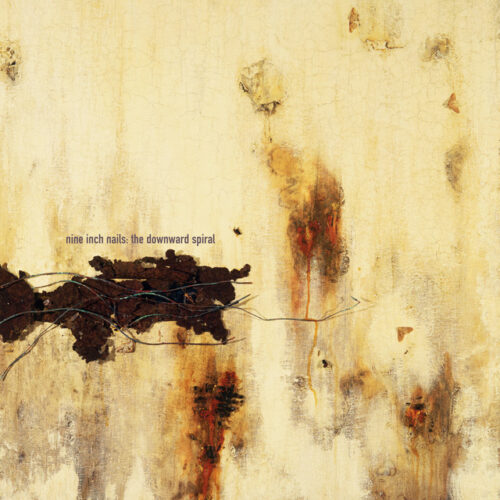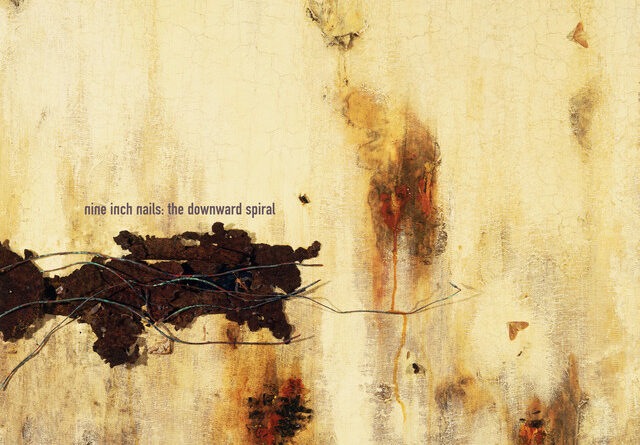HEAVY MUSIC HISTORY: The Downward Spiral – Nine Inch Nails
Concept albums are generally dark affairs. 1982’s The Wall by PINK FLOYD talks about the descent into madness of a rockstar burdened by his past. GREEN DAY‘s magnum opus American Idiot (2004) discusses the disillusionment and dissent of a generation navigating young adult life in a post 9/11 world. Even Tommy (1969), which saw THE WHO talk about the great, arcade pastime of pinball, is enveloped in a world of coercion, psychosis and abusive relationships. But perhaps no record has ever gone to the depths that one Michael ‘Trent’ Reznor took his industrial upstart project NINE INCH NAILS on in the early to mid 1990’s. An album that stands as tall as it did on release on March 8th, 1994, The Downward Spiral remains arguably the greatest work of Reznor‘s illustrious career.
NINE INCH NAILS had been making a name for themselves on 1993’s Lollapalooza tour with their aggressive live shows, but their rising star began to leave Reznor alienated and disinterested. Coupled with his brewing feud with Interscope subsidiary TVT Records, Reznor began to flesh out The Downward Spiral‘s story of a misanthropic man who rebels against humanity, kills God and then eventually attempts suicide. It would soon begin to mirror his personal life as he battle with drug addiction and depression, although declined to be medicated for the latter.
Prior to the release of the band’s debut record Broken in 1992, Reznor had moved into 10050 Cielo Drive in Beverley Hills, LA, a residence known for being the site of the infamous murder of Sharon Tate by The Manson Family in 1969. Reznor would build a studio in the living room called Le Pig, named after the phrase daubed on the front door by The Manson Family in Tate‘s blood and recruited drummer Stephen Perkins (JANE’S ADDICTION, PORNO FOR PYROS), guitarist Adrian Belew and band drummer Chris Vrenna. The three would play freely, their music then rendered into loops and samples by Reznor, who added them to the album as and when required to keep in line with the album’s themes; he also made use of keyboards and Pro Tools among other apparatus. British producer Flood was brought in to help with the production alongside Reznor, although this would be their last collaboration due to creative differences, and the recording process was wrapped up in late 1993; Reznor moved out of 10050 Cielo Drive shortly after, and the property was then demolished.
Despite the album having a resemblance of a storyline running through it, a lot is left open to interpretation. Embracing nihilism and self-abuse, the protagonist – in Reznor‘s own words to Select magazine in April 1994 – “sheds everything around them to a potential nothingness, but through career, religion, relationship, belief and so on”. With a plethora of different styles, from metal to techno, industrial to electronic, and a non-conforming song structure that never stays regular from one track to the next, part of the record’s legacy is that it leaves the listener never expecting, always on tenterhooks. The full on, anguished assault of Mr. Self Destruct segues into the quieter and menacing Piggy, lead single March Of The Pigs is pacey and chaotic, right up until the final lines of the chorus where it immediately becomes just Trent and a piano, and A Warm Place is the closest the album gets to a peaceful moment, a surprising gentle few minutes in an otherwise raging storm.
It’s impossible to talk about The Downward Spiral without talking about arguably its two most famous tracks. Closer, which has a heavily sampled kick drum from IGGY POP‘s Nightclubbing, is about officially self-hatred and obsession, but has become an anthem for lust owing to its sensual feel and chorus hook “I wanna fuck you like an animal“, much to the dismay of Reznor. Meanwhile, closing track Hurt, which makes reference to self-harm and addiction, would be looked at as coda of self-reflection long before JOHNNY CASH covered it in 2003, but the country star’s delicate, beautiful rendition that served as his final, non-posthumous single lifted the original to a much higher status. Perhaps the most potent element of the record, though, is Reznor‘s lyrics, which convey a myriad of emotions befitting such an audible rollercoaster. The recurring hook of “Nothing can stop me now” is a highlight, as is Trent‘s ferocious cry of “God is dead, and no one cares” during Heresy, while the spoken word interludes in I Do Not Want This and the avant-garde verses of Reptile are poetry in its greatest form, sublime yet delivered with a mouth full of broken glass.
Garnering instant success and critical acclaim on release, The Downward Spiral debuted at #2 on the Billboard 200 and was quadruple platinum within three years; to date, it’s shifted 4 million copies in the USA alone. In the UK, it broke into the Top Ten and went gold and it remains NINE INCH NAILS‘ best-selling album of all time. The band embarked on the highly successful Self Destruct Tour in support, a run that included their infamous, mud-soaked performance at Woodstock 1994. They would go on to higher spots in charts across the world with the likes of 1999’s The Fragile and 2005’s With Teeth, but the darkness and bleakness of this sophomore release is what made the band – and Trent Reznor – household names and one of the greatest musical forces of three decades ago.

The Downward Spiral was originally released on March 8, 1994 via Interscope Records.
Like NINE INCH NAILS on Facebook.

